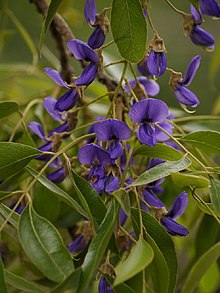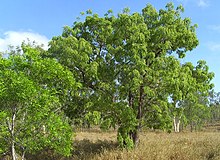Bolusanthus
| Bolusanthus | |
|---|---|

| |

| |
| Habit | |
| Scientific classification | |
| Kingdom: | Plantae |
| Clade: | Tracheophytes |
| Clade: | Angiosperms |
| Clade: | Eudicots |
| Clade: | Rosids |
| Order: | Fabales |
| Family: | Fabaceae |
| Subfamily: | Faboideae |
| Tribe: | Sophoreae |
| Genus: | Bolusanthus Harms (1906) |
| Species: | B. speciosus
|
| Binomial name | |
| Bolusanthus speciosus (Bolus) Harms (1906)
| |
| Synonyms[1] | |
| |
Bolusanthus speciosus (tree wisteria) is a species of flowering plants in the family Fabaceae. It belongs to the subfamily Faboideae. It is the only member of the genus Bolusanthus .[2][3][4]
Description[edit]
It is a small deciduous tree, which can grow up to 7 m (23 ft) tall. It has black, fissured rough bark and also drooping branches. Between September and October, when the tree has no leaves it begins to bloom, with lilac blue flowers. Later it produces a seed capsule, the grey pods contain 3-8 smooth, bright yellow or brown seeds.[5]
The wood is very hard, heavy and yellow in colour. It can be used for axe-handles, wagon spokes and fencing poles. The tree is also grown in gardens due to the attractive flowers.[5]
Distribution[edit]
It is native to KwaZulu-Natal and Northern Provinces (of South Africa), Eswatini, Botswana, Malawi, Mozambique, Zambia and Zimbabwe.[1] It is found in low to medium elevations in woodland or wooded grasslands.[5]
Taxonomy[edit]
The genus name of Bolusanthus is in honour of Harry Bolus, (1834 – 1911) who was a South African botanist, botanical artist, businessman and philanthropist,[6] and 'anthus' the Greek word for flower.
It was first published and described by (Bolus) Hermann Harms (a German botanist) in Repert. Spec. Nov. Regni Veg. 2: 15 in 1906.[1]
References[edit]
- ^ a b c "Bolusanthus speciosus (Bolus) Harms | Plants of the World Online | Kew Science". Plants of the World Online. Retrieved 13 August 2023.
- ^ "The Plant List entry for Bolusanthus". The Plant List. Royal Botanic Gardens, Kew and the Missouri Botanical Garden. 2013. Retrieved 14 May 2014.
- ^ "ILDIS LegumeWeb entry for Bolusanthus". International Legume Database & Information Service. Cardiff School of Computer Science & Informatics. Retrieved 14 May 2014.
- ^ USDA; ARS; National Genetic Resources Program. "GRIN species records of Bolusanthus". Germplasm Resources Information Network—(GRIN) [Online Database]. National Germplasm Resources Laboratory, Beltsville, Maryland. Archived from the original on 24 September 2015. Retrieved 14 May 2014.
- ^ a b c Drummond, R.B., ed. (1972). The Bundu Book of Trees, Flowers and Grasses (2nd ed.). Salisbury, Rhodesia: Longman Rhodesia. p. 35. ISBN 058257532X.
- ^ Burkhardt, Lotte (2018). Verzeichnis eponymischer Pflanzennamen – Erweiterte Edition [Index of Eponymic Plant Names – Extended Edition] (pdf) (in German). Berlin: Botanic Garden and Botanical Museum, Freie Universität Berlin. doi:10.3372/epolist2018. ISBN 978-3-946292-26-5. Retrieved 1 January 2021.
 Data related to Bolusanthus at Wikispecies
Data related to Bolusanthus at Wikispecies Media related to Bolusanthus at Wikimedia Commons
Media related to Bolusanthus at Wikimedia Commons
